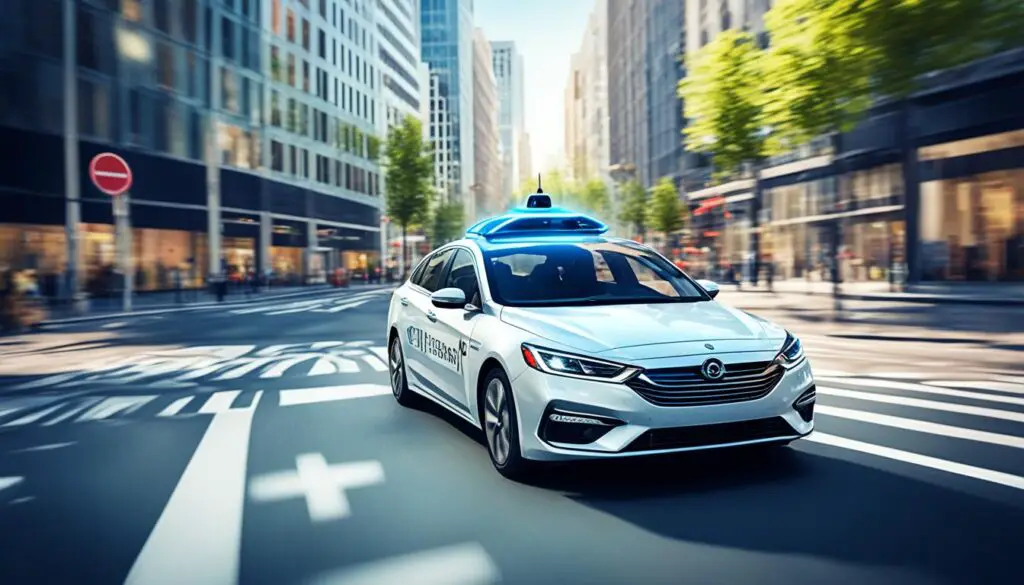
Driver Assistance Technologies: Safer Journeys Ahead
As technology advances, so does our capability to enhance road safety and ensure secure travel. One area where remarkable progress has been made is in driver assistance technologies. These cutting-edge systems leverage advanced sensors, cameras, and artificial intelligence to assist drivers in various aspects of their journey, from collision avoidance to navigation and parking assistance.
With driver assistance technologies, we can now look forward to safer and stress-free journeys on the road. Gone are the days of relying solely on human reflexes and attention. These innovative systems work tirelessly to enhance road safety and simplify navigation, making our travel experiences more secure and convenient.
Key Takeaways:
- Driver assistance technologies utilize advanced sensors, cameras, and AI to enhance road safety and simplify navigation.
- These technologies have shown a significant impact on reducing accidents and fatalities on the road.
- Driver assistance features, such as collision avoidance and lane-keeping assist, help prevent accidents caused by human error.
- Integrated GPS navigation systems provide real-time traffic information and alternative route suggestions for efficient travel.
- Driver assistance technologies enhance the overall driving experience, making it more secure and stress-free.
The Impact of Driver Assistance Technologies on Road Safety.
Driver assistance technologies have had a significant impact on road safety. According to studies, vehicles equipped with driver assistance features have shown a reduction in accidents and fatalities. For example, collision avoidance systems have been found to reduce rear-end collisions by up to 50%. Lane-keeping assist systems help prevent lane departure accidents, which are a leading cause of accidents on the road. Adaptive cruise control, which automatically adjusts the vehicle’s speed to maintain a safe distance from other vehicles, has proven effective in reducing the risk of collisions. These technologies work together to create a safer driving environment and minimize the potential for human error.
The implementation of driver assistance technologies has been instrumental in improving road safety. By utilizing advanced sensors, cameras, and artificial intelligence, these technologies can detect potential hazards and assist drivers in taking appropriate actions to avoid accidents. The integration of these systems into vehicle design has led to a significant reduction in the number of accidents and fatalities on the roads.
One notable example of the impact of driver assistance technologies on road safety is the reduction in rear-end collisions. Rear-end collisions are a common type of accident, often caused by driver inattention or delayed response. Collision avoidance systems, such as automatic emergency braking, use sensors to detect the distance between vehicles and apply the brakes if a collision is imminent. These systems have proven to be highly effective, reducing rear-end collisions by up to 50%.
Lane departure accidents, where vehicles drift out of their designated lanes, are another leading cause of accidents on the road. Lane-keeping assist systems use cameras and sensors to monitor the vehicle’s position on the road and provide gentle steering inputs to keep the vehicle within the lane. By alerting drivers to lane departures and assisting in correcting drift, these systems help prevent accidents and ensure safer journeys.
Adaptive cruise control is another driver assistance technology that significantly improves road safety. By automatically adjusting the vehicle’s speed to maintain a safe distance from the vehicle ahead, adaptive cruise control reduces the risk of rear-end collisions caused by inadequate following distance or driver distraction. This feature helps drivers maintain a consistent speed and distance, contributing to a safer driving environment.
Overall, driver assistance technologies have transformed the way we drive and have had a profound impact on road safety. With their ability to detect and mitigate potential hazards, these technologies play a crucial role in preventing accidents and saving lives. As technology continues to advance, further innovations in driver assistance systems are expected, leading to even safer roads for all.

Simplifying Navigation with Driver Assistance Technologies.
Driver assistance technologies not only improve safety but also simplify navigation for drivers. GPS navigation systems integrated with driver assistance features provide real-time traffic information, route guidance, and alternative route suggestions to help drivers navigate efficiently.
Voice commands and intuitive user interfaces make it easier for drivers to interact with these systems while keeping their attention on the road. By simply speaking commands or using touch controls, drivers can access navigation features without having to take their hands off the wheel or eyes off the road.
In addition to traditional navigation functions, some driver assistance technologies also offer advanced features like automatic parking assistance. These systems use sensors and cameras to accurately park the vehicle in tight spaces, relieving drivers from the stress and hassle of maneuvering in cramped parking lots.
Overall, driver assistance technologies enhance the driving experience by simplifying navigation and providing convenience. With these technologies, drivers can confidently navigate unfamiliar areas, avoid traffic congestion, and effortlessly park their vehicles, leading to a smoother and more enjoyable journey.
FAQ
How do driver assistance technologies improve road safety?
Driver assistance technologies utilize advanced sensors, cameras, and artificial intelligence to aid drivers in collision avoidance, lane-keeping, adaptive cruise control, and parking assistance. These technologies work together to minimize the potential for human error, reducing accidents and fatalities on the road.
What is the impact of driver assistance technologies on road safety?
Studies have shown that vehicles equipped with driver assistance features have experienced a significant reduction in accidents and fatalities. For example, collision avoidance systems have been found to reduce rear-end collisions by up to 50%, while lane-keeping assist systems help prevent lane departure accidents, a leading cause of accidents on the road.
How do driver assistance technologies simplify navigation?
Driver assistance technologies integrate GPS navigation systems with real-time traffic information, route guidance, and alternative route suggestions. Voice commands and intuitive user interfaces make it easier for drivers to interact with these systems while keeping their attention on the road, enhancing the overall driving experience.
